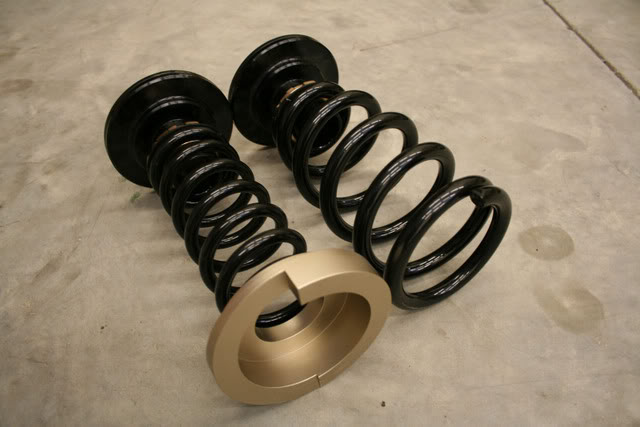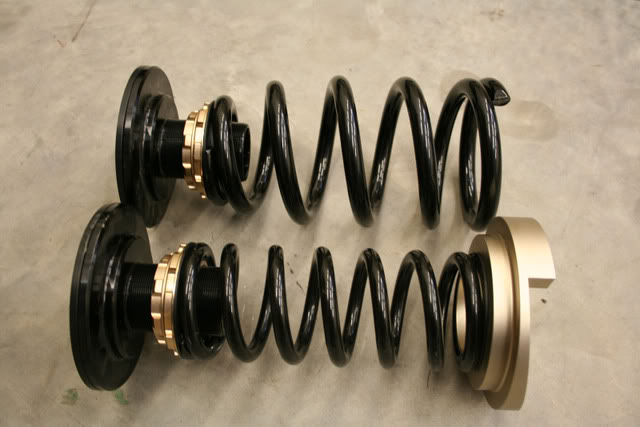Guys with BC coilovers - need help!!
#33
#36
Originally Posted by redlude97
how are they not progressive when the springs are wound at what appears to be the same spacing while the coil diameter gets smaller
#37
Originally Posted by redlude97
how are they not progressive when the springs are wound at what appears to be the same spacing while the coil diameter gets smaller
Originally Posted by Glex25
If you have the newer springs(:Progressive) that are kind of fat in the middle you don't need the lower bucket according to Pete@BcRacing.
No clunking sound here.
I adjust springs first and then adjust the shock body until it gets tight or vice versa.
Remember you don't want slack on your springs cause that means that you will be riding on more shock than spring and can blow out your shock body.
No clunking sound here.
I adjust springs first and then adjust the shock body until it gets tight or vice versa.
Remember you don't want slack on your springs cause that means that you will be riding on more shock than spring and can blow out your shock body.
Last edited by Glex25; 07-10-2008 at 09:58 PM.
#38
Originally Posted by Klubbheads
coil diameter has nothing to do with the spring progressive or not. Pitch rate is more of an indicator if the spring is progressive or not. In the pics provided it looks like both of them have the same pitch rate from top to bottom so both of them are most likely linear.

#39
Originally Posted by Klubbheads
coil diameter has nothing to do with the spring progressive or not. Pitch rate is more of an indicator if the spring is progressive or not. In the pics provided it looks like both of them have the same pitch rate from top to bottom so both of them are most likely linear.
I'm clearly not a suspension expert... in fact the more knowledge I can gain here, the better position I'll be in to make the right decision.
Frankly, I'm not entirely swayed form keeping Eibacs and using D-specs
*Edit: I didnt read redludes post prior to mine... he says it a little clearer. (hard to carry biz converations and this at the same time
 )
)
#40
black guy... can you clear this up please... also, you never responded in the other thread as to whether these are still available: https://g35driver.com/forums/showthr...=204686&page=7
#41
Originally Posted by redlude97
of course it does. If the spacing between coils remains the same while the diameter decreases, guess what! the pitch rate changes! 

#42
Originally Posted by Klubbheads
Im not sure if a chose the correct word to explain but if the distance between each roll is the same and the force is vertical, which in our case it is, then spring is linear because it takes the same amount of force to compress the spring for each lets say inch. If the spring is denser in the bottom then that would automatically be progressive.
Look up a conical spring, if the spacing(pitch) between the springs is the same while the diameter changes, then it has a nonlinear springrate. No linear spring requires the same amount of force to compress it each inch. A linear spring refers to a constant springrate, but the force changes proportionally to the compression, which is governed by hooke's law f=-kx, where in a linear spring k is constant, while in a progressive spring k=k(x). Now if the conical section of the spring in question is fully compressed with the weight of the car, then the rear spring behaves as a linear spring even though technically it doesn't have a linear construction
Conical helical spring can be designed in two ways
1. As a linear spring where the pitch is variable so that all coils will come to touch each other at the same time when pressed to solid.
2. As a non-linear spring where the pitch is constant. Therefore the largest coil will touch the coil above it first and then the second and so on thereby, creating a non-linear rate spring where each time a coil reaches the coil above it the number of active coils decrease and the rate of the spring increase.
The rate of the first type of spring can be calculated/estimated as a standard helical coil using the average diameter of the conical spring. The stresses should be calculated with respect to the largest diameter because the stresses are the highest at the largest coil.
Calculating the variable rate of the second type is more complicated and done in steps. First you treat the spring as a normal spring until the largest coil touches the coil above it. Then you deduct one coil and do the calculations until the next coil touches the coil above it and so on. Since the smallest coil will be the last to work, the stresses are calculated with respect to the smallest coil.
1. As a linear spring where the pitch is variable so that all coils will come to touch each other at the same time when pressed to solid.
2. As a non-linear spring where the pitch is constant. Therefore the largest coil will touch the coil above it first and then the second and so on thereby, creating a non-linear rate spring where each time a coil reaches the coil above it the number of active coils decrease and the rate of the spring increase.
The rate of the first type of spring can be calculated/estimated as a standard helical coil using the average diameter of the conical spring. The stresses should be calculated with respect to the largest diameter because the stresses are the highest at the largest coil.
Calculating the variable rate of the second type is more complicated and done in steps. First you treat the spring as a normal spring until the largest coil touches the coil above it. Then you deduct one coil and do the calculations until the next coil touches the coil above it and so on. Since the smallest coil will be the last to work, the stresses are calculated with respect to the smallest coil.
#43
#44
Originally Posted by redlude97
I misused the term "pitch" in my explanation. By pitch I meant the angle the spring forms. I forget that its usually defined as the spacing.
Look up a conical spring, if the spacing(pitch) between the springs is the same while the diameter changes, then it has a nonlinear springrate. No linear spring requires the same amount of force to compress it each inch. A linear spring refers to a constant springrate, but the force changes proportionally to the compression, which is governed by hooke's law f=-kx, where in a linear spring k is constant, while in a progressive spring k=k(x). Now if the conical section of the spring in question is fully compressed with the weight of the car, then the rear spring behaves as a linear spring even though technically it doesn't have a linear construction
Look up a conical spring, if the spacing(pitch) between the springs is the same while the diameter changes, then it has a nonlinear springrate. No linear spring requires the same amount of force to compress it each inch. A linear spring refers to a constant springrate, but the force changes proportionally to the compression, which is governed by hooke's law f=-kx, where in a linear spring k is constant, while in a progressive spring k=k(x). Now if the conical section of the spring in question is fully compressed with the weight of the car, then the rear spring behaves as a linear spring even though technically it doesn't have a linear construction
Conical helical spring can be designed in two ways
1. As a linear spring where the pitch is variable so that all coils will come to touch each other at the same time when pressed to solid.
2. As a non-linear spring where the pitch is constant. Therefore the largest coil will touch the coil above it first and then the second and so on thereby, creating a non-linear rate spring where each time a coil reaches the coil above it the number of active coils decrease and the rate of the spring increase.
The rate of the first type of spring can be calculated/estimated as a standard helical coil using the average diameter of the conical spring. The stresses should be calculated with respect to the largest diameter because the stresses are the highest at the largest coil.
Calculating the variable rate of the second type is more complicated and done in steps. First you treat the spring as a normal spring until the largest coil touches the coil above it. Then you deduct one coil and do the calculations until the next coil touches the coil above it and so on. Since the smallest coil will be the last to work, the stresses are calculated with respect to the smallest coil.
1. As a linear spring where the pitch is variable so that all coils will come to touch each other at the same time when pressed to solid.
2. As a non-linear spring where the pitch is constant. Therefore the largest coil will touch the coil above it first and then the second and so on thereby, creating a non-linear rate spring where each time a coil reaches the coil above it the number of active coils decrease and the rate of the spring increase.
The rate of the first type of spring can be calculated/estimated as a standard helical coil using the average diameter of the conical spring. The stresses should be calculated with respect to the largest diameter because the stresses are the highest at the largest coil.
Calculating the variable rate of the second type is more complicated and done in steps. First you treat the spring as a normal spring until the largest coil touches the coil above it. Then you deduct one coil and do the calculations until the next coil touches the coil above it and so on. Since the smallest coil will be the last to work, the stresses are calculated with respect to the smallest coil.
Every kg/lb force on a linear spring will have the same effect throughout the springs compression no matter how much it compresses.




